Whilst they came into Euro 2024 as the defending champions, there weren’t many who gave Italy a chance of retaining the trophy, and instead, they were written off in many quarters as one of those teams that could underperform.
This was an understandable judgement to make, given that head coach Luciano Spalletti has only been in his post since August 2023 and so has not had long to get his ideas across, and the general feeling was that this tournament might have come just too soon for them to really make an impact.
However, Italian football has always been about creating headlines and achieving the seemingly unattainable, with Napoli ending their long wait for a Serie A title (stretching back to 1990) in the 2022/23 season and Italy’s triumph at Wembley Stadium three years ago (which saw them become European champions for the first time since 1968) among the stories to have put the spotlight on Europe’s tenth-largest country.
With that in mind, perhaps it should have been expected that Tuesday night’s final group stage game against Croatia would end in the dramatic circumstances that it did, with a late equaliser secured with the final touch of the ball securing Italy’s place in the knockout rounds at their opponents’ expense.
Nevertheless, there is no denying that Spalletti’s team have not been at their best so far, with a lot that they have done well but plenty that they still need to work on.
This tactical analysis and team-based scout report will highlight what needs attention if they are to continue defying expectations.
Italy’s Lack of attacking threat
When it comes to their attacking play, it has been abundantly clear what Spalletti wants to see from his side, with their tactics based around being expansive whenever they have the ball and manipulating their opposition into leaving spaces open.
Whilst that has led to some success, there have been plenty of moments when they could have done better, and ensuring that they are as clinical as possible when they do get into dangerous areas will be vital if they are to go deep into the competition.

A lot of what has let them down has, in many ways, come down to the overall speed of Italy’s build-up play.
They have the ability to find each other with precise passes but lack pace when doing so, which has led to many of their offensive moves being brought to a premature end.
This situation highlighted how much that has limited their ability to test their opponents.
The ball is travelling towards right-back Giovanni Di Lorenzo from the middle, and in a typical diagonal fashion, the aim now has to be getting the ball down and targeting the unguarded territory that Croatia have left exposed behind them.
However, the fact that Italy don’t have any runners able to meet a potential cross means that that is not immediately possible, and Di Lorenzo is forced to hold onto the ball for longer than he should have done.
As a result, Croatia has been gifted time to both get back into position and close the ball down. Manchester City defender Joško Gvardiol further limits the Napoli captain’s options, so the ball is therefore sent backwards for Italy to find another way through.
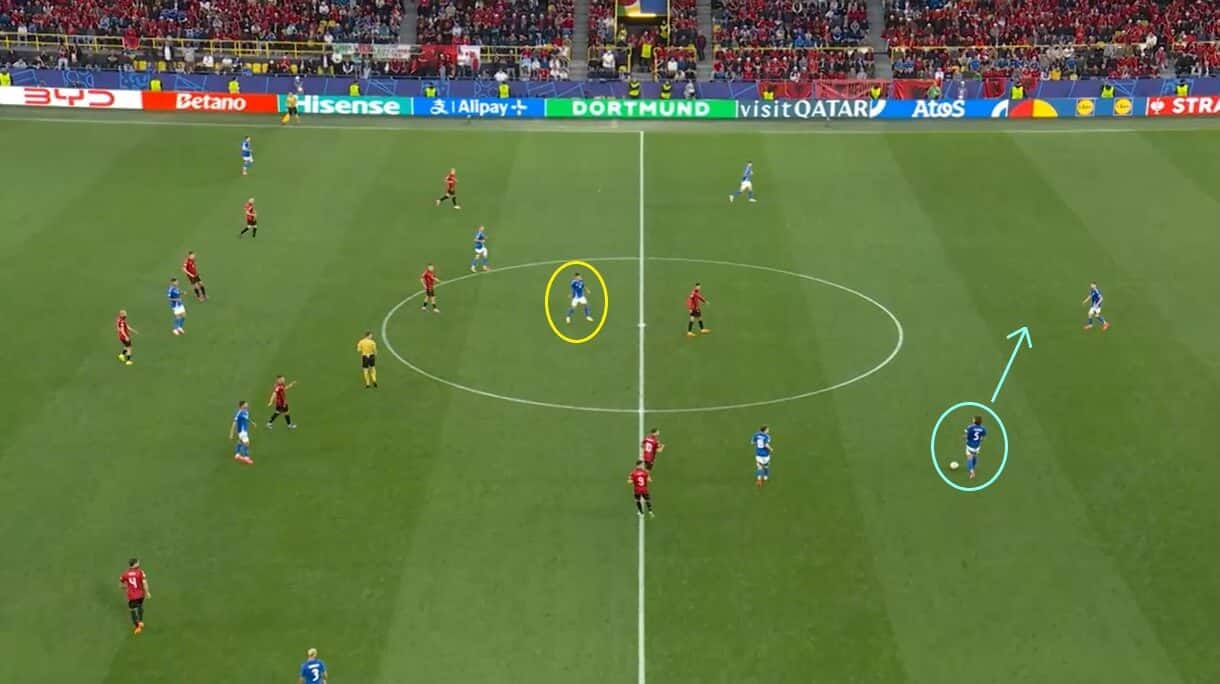
That is not the only time when a lack of speed has been apparent, though, with it also clear to see when the ball is further back and when Italy are looking to instigate an attacking sequence of passes.
In this case, Bologna centre-back Riccardo Calafiori has possession and has been faced with the block that Albania have become so known for in Germany, but the key thing is that they have left spaces open and so have allowed Di Lorenzo to get between them and to give Calafiori a forward passing option here.
Many in this position might have taken that option, with Di Lorenzo having time to control the ball and then to send it onwards, but Calafiori opts not to do so and instead sends it across the pitch and towards Alessandro Bastoni, with him feeling that the risk of playing into the gap is too great at this moment in time.
He should be praised for playing in a risk-free manner and for backing himself when he needed to make a decision, and this horizontal pass certainly fits in with Spalletti’s desire to not give the ball away unnecessarily and is a reason that Italy have so far averaged 52.56% possession per game.
However, not every team will sit back in the way that Albania did and, so Italy will need to be braver and will need to make forward passes a lot earlier than they have been doing so far, and that, therefore, again, highlights how a lack of speed is something that they will need to look at if they are to extend their stay at Euro 2024.
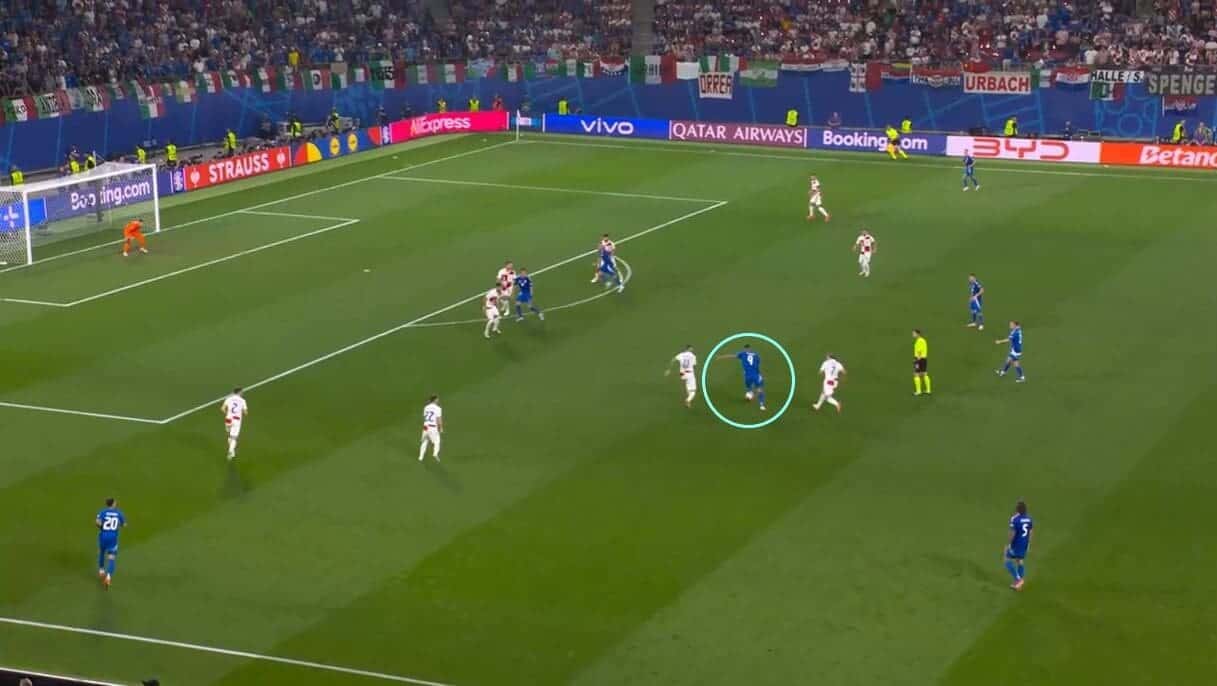
That is not the only aspect of Italy’s attacking play that needs some work, though.
Another factor inhibiting their overall threat is the strikers’ desire to drop back into deeper positions to participate in build-up play.
As with conservative passing, it is not something that should be completely discouraged, and it is a critical factor of modern footballing tactics. However, Italy has encountered an issue as a result of allowing it: They have not been able to shoot at goal with much vigour because their key target players are too far away from it.
That is shown clearly here, with former West Ham United player Gianluca Scamacca shooting from a long way out and therefore seeing his effort not test the goalkeeper that severely, and this is the main reason that Italy have only scored three times to date.
Therefore, whilst Italy can still have its strikers drop back, it needs them to recognise when they are required to stay higher up the pitch and provide a focal point.
That will improve their overall output inside the final third and give them a better chance of continuing to defy those who doubt their credentials.
Italy Defensive gaps
When it comes to defending, Italy has once again been largely getting things right. Their structure is fairly solid, and they have once again demonstrated a clear tactical understanding of what Spalletti wants from them.
However, there have been areas of weakness in their work without the ball that have let them down, and the fact that they have not kept a clean sheet in any of their group games is not something to ignore.
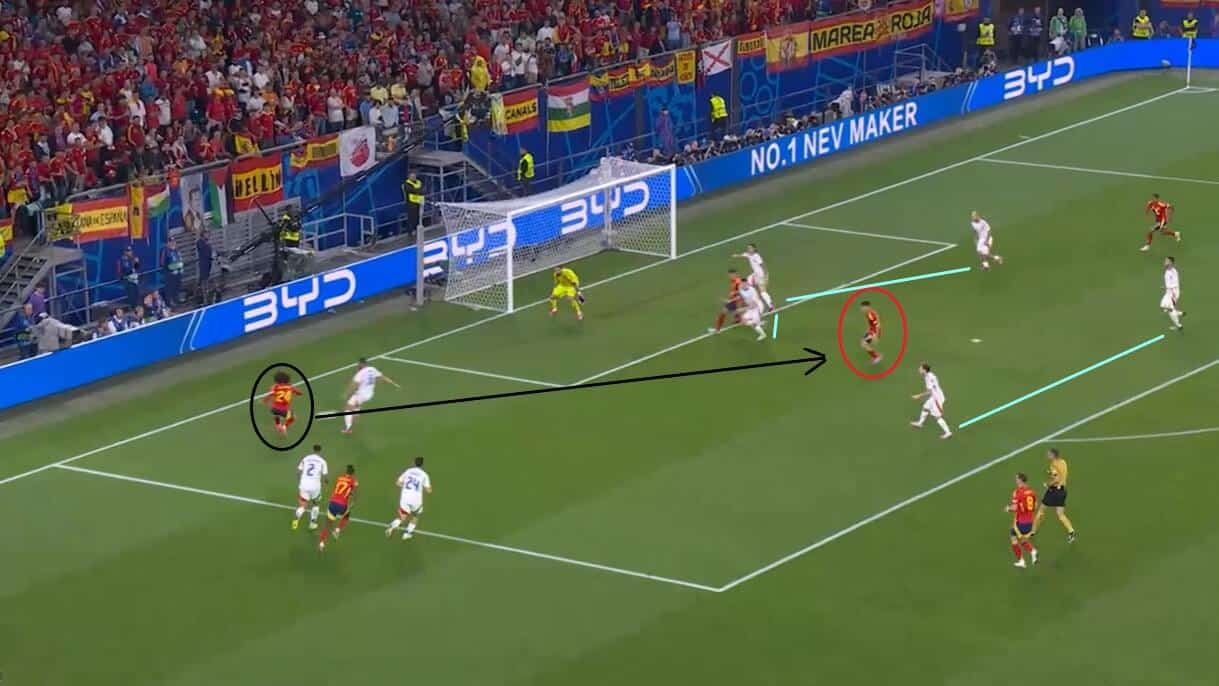
One reason they have let in three goals so far is that they have, at times, lost the coordination that has been apparent in so much of their play and have left themselves too open and exposed whenever opponents have moved into dangerous positions.
Spain, in particular, really targeted this and used it to their advantage. They looked to make runs off the ball that facilitated cutback passes from wider areas, and this proved to be highly effective in breaking Italy down.
This situation highlights how much this hurt Italy at times. Italy initially set up with their usual lines in front of goal and appeared solid, but they were undone here by two details in Spain’s attack.
Firstly, the underlapping run made by Chelsea left-back Marc Cucurella, which allowed the highly-sought-after Nico Williams to send the ball towards the goal line, and the second by the movement of striker Álvaro Morata, who moved towards the goal and took the Italian back line with him.
Where Italy went wrong here is that the two in front of the defenders, Nicolò Barella and Lorenzo Pellegrini, needed to then go with them, ensuring that they were not prised apart and left a gap open between them.
However, because they ended up holding their position on the edge of the goal area, Cucurella could move the ball into the gap and give Pedri a shot on goal, with only his inability to convert letting Italy off here.
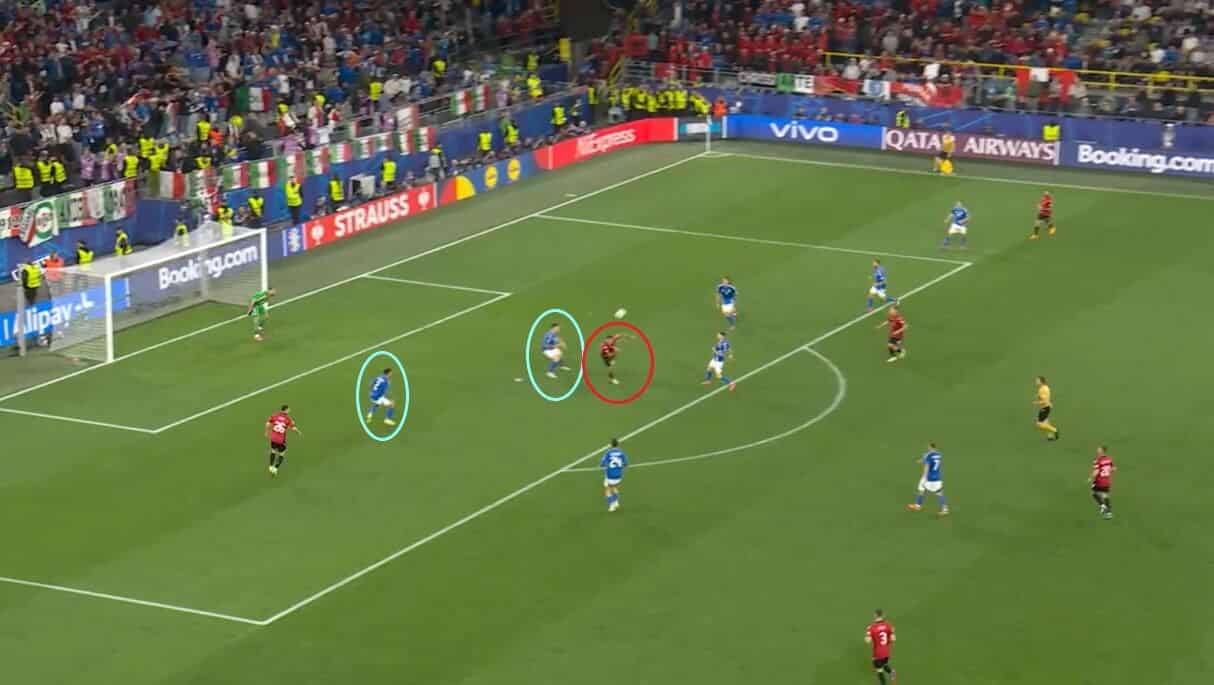
Italy’s other weakness has been its poor aerial play, which has hindered its ability to keep opponents out at times. Although it manages to avert many threats on the ground (having won 60% of its defensive duels to date), it looks uncomfortable whenever it is tested in the air.
This is shown through them only succeeding in 39.7% of their aerial battles.
It was apparent from the very first match that Albania’s long ball tactics allowed them to continually exploit this weakness.
In this case, it is highlighted through Qazim Laçi crossing the ball towards former Watford striker Rey Manaj and none of Calafiori or Di Lorenzo clearing their lines.
It was perhaps too far ahead of the former here, but Di Lorenzo certainly had a chance to move into the space where the ball landed and to intercept the pass, and yet his inability to do so meant that the ball was allowed to run through to Arbër Hoxha, who then set up Mario Mitaj to have a shot on goal.
Whilst it did go wide of the target, it was a chance that could have been prevented, and that is the key point to make.
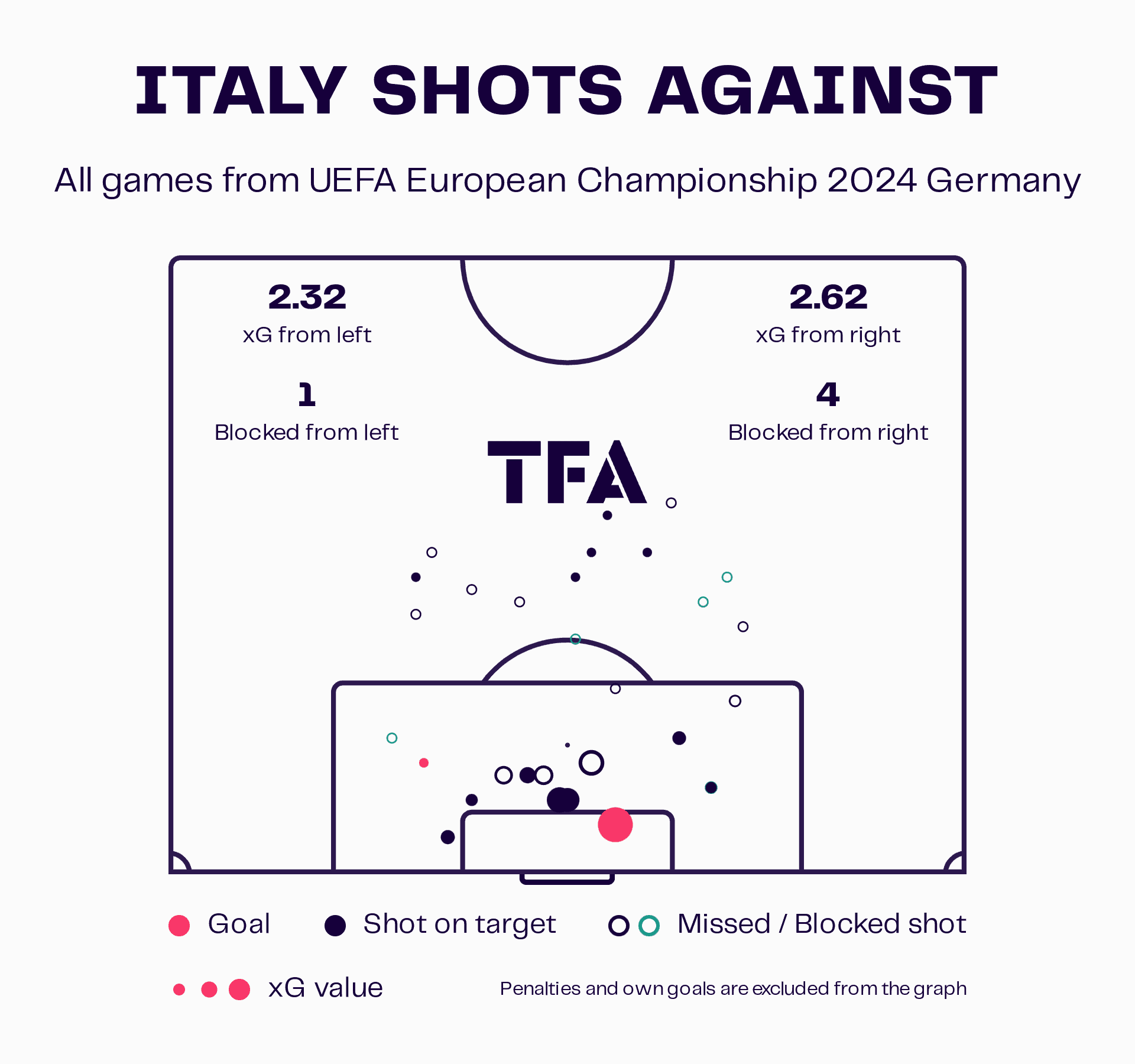
Whilst the match against Albania really highlighted Italy’s inability to deal with aerial threats, with them only winning 23.81% of their contests in the air in that match alone (five out of 21 to be exact), it was not a one-off.
The fact that many of their opponents’ shots on target have come from inside the goal area highlights the lack of security that they have had further back.
At the same time, the contrast between that and their ability to defend higher up the pitch is also clear, with them making several blocks outside of the goal area.
So, there is a definite need for them to be tougher to beat around their goal and to ensure that they never allow their opponents any cheap chances to test their resolve.
Things to be optimistic about
What has become clear throughout this analysis is that Italy has a list of things that need to be fixed ahead of the knockout stages getting underway, but there has been a lot that they can be pleased with so far and which they can take a great deal of confidence from, and it is true to say that they are capable of causing a few surprises over the coming rounds and of perhaps progressing further than many might have predicted.
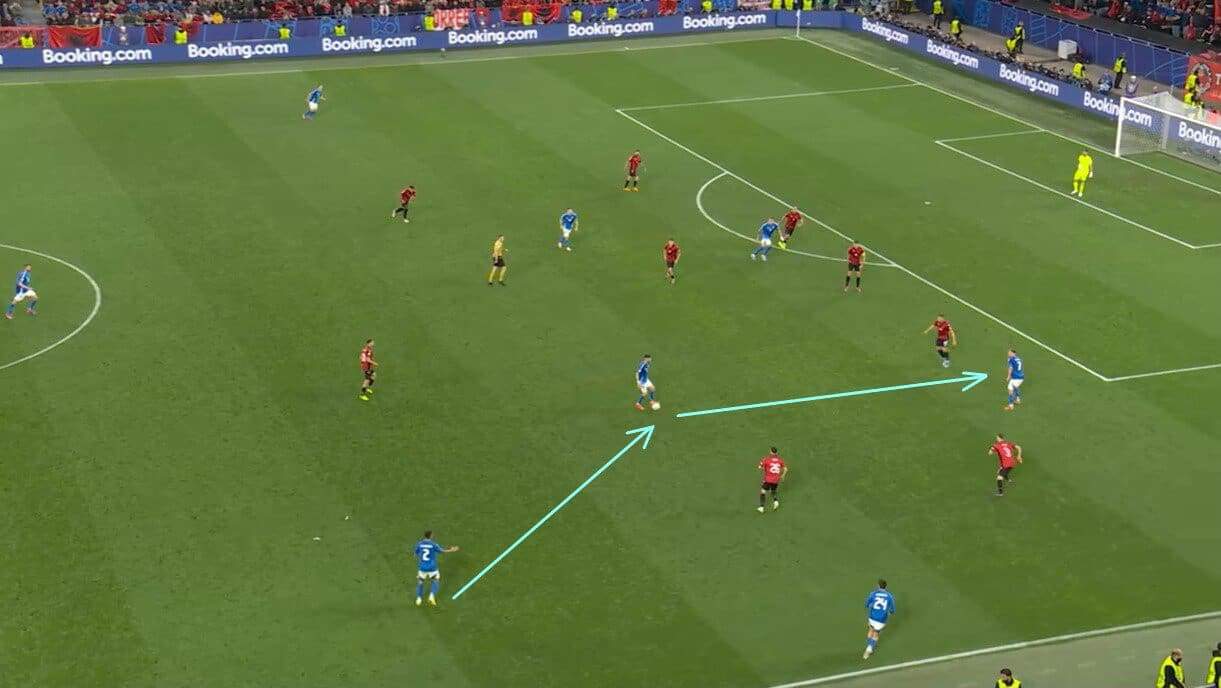
For one thing, their ability to play at a high tempo and to be progressive in possession has been apparent at times, with this situation seeing Di Lorenzo feed the ball into the path of Jorginho, who then takes just one touch to steady the ball before sending it onwards and towards Davide Frattesi.
By doing so, Italy have looked to get the ball into a dangerous position before Albania have had a chance to set up their defensive shape, and it paid off here as Sylvinho’s side were unable to reach Frattesi’s cross when it did come in.
The opportunity might not have led to anything on this occasion, but it is a clear demonstration of the positivity that Italy can gain when they do inject some pace and urgency into their play.
They might have an 89% passing accuracy so far in the tournament, which indicates that they are generally tidy when in control of the ball, but every team needs to have an ability to switch on the burners when gaps do open up.
Italy showed here that they are capable of doing that, and so now they need to do it more often.
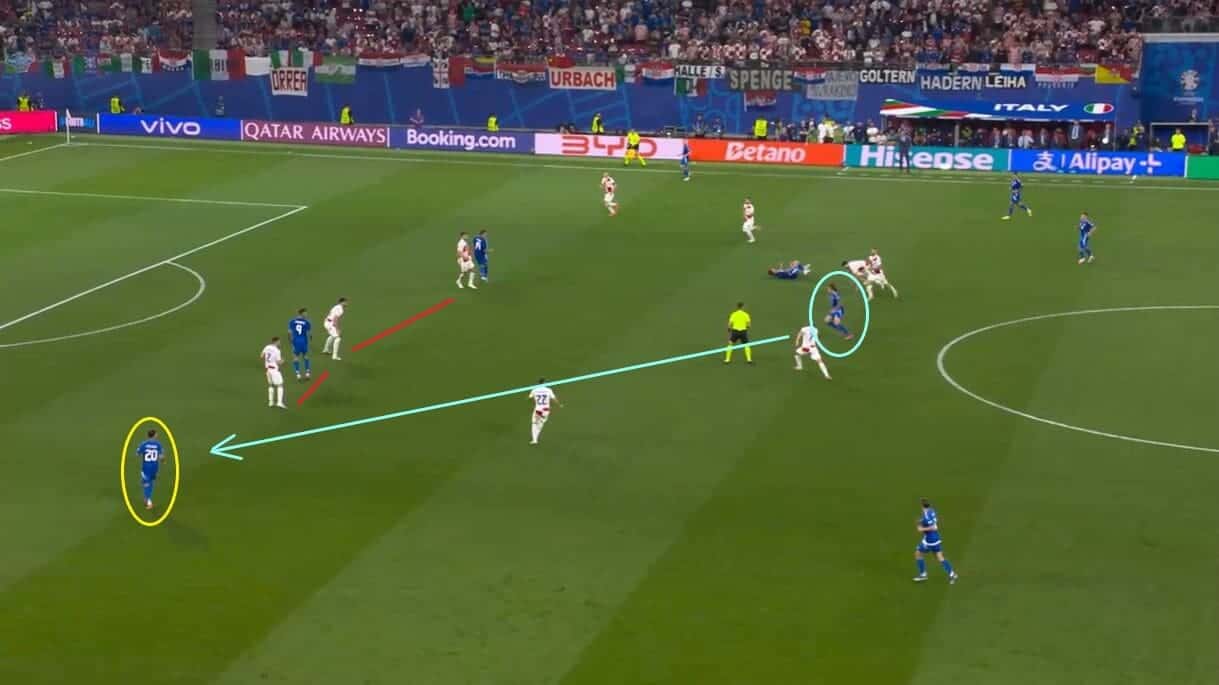
They have also demonstrated an ability to manipulate their opponents into leaving gaps open, which is always something that teams with aspirations of going deep into a major tournament need to have in their skillset.
However, the key thing to point out about Italy’s build-up play is that a lot of it starts at the back.
The scout report showed earlier that Calafiori and Bastoni got into advanced positions and became quasi-midfielders when the team was in possession.
That, in turn, has allowed more players to push further up the field, making it harder, in theory, for opposing sides to marshal every one of their potential goal threats.
The issue that Croatia came across here is that, when Gvardiol pushed out to try and win the ball here, he was caught out by Calafiori and Juventus midfielder Nicolò Fagioli playing a one-two to take him out of the game.
As a result, the back line then needed to shift even further inside the pitch in order to fill the gap that had been left exposed, which increased the distance between right-back Josip Stanišić and Lazio winger Mattia Zaccagni.
It was that that then allowed Calafiori to send the ball into Zaccagni’s path and to facilitate the equalising goal.
In short, when Italy gets the details of their play right and works the spaces well, they are a difficult team to contain and one that provides plenty of enjoyment for fans to watch.
They now need to focus on ensuring that they do that on a more regular basis.
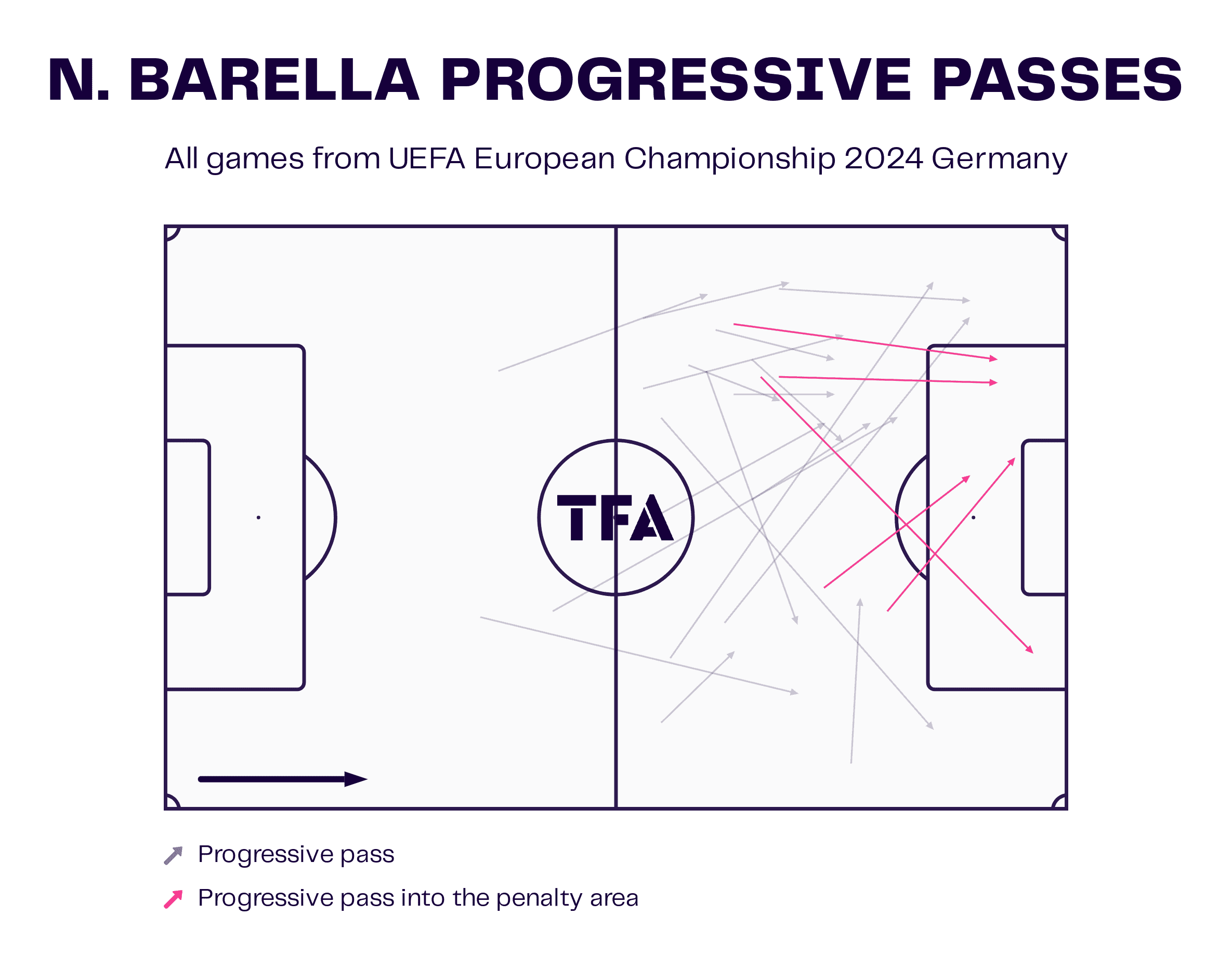
In addition to the team performances, there have also been a number of strong individual displays over their three group games.
Bastoni and Calafiori have been picked out by many analysts and pundits, but one player who has proven himself to be instrumental to everything that Italy does well is Barella.
He sits in deeper spaces and is the anchor for so much of their build-up play.
As this graphic indicates, the Inter player has been the source of many of Italy’s positive chances.
He makes a number of progressive passes and constantly shifts the ball into different areas of the field.
His ability to do this has allowed the likes of Di Lorenzo and Federico Dimarco to play in higher spaces on the wings and has freed players like Frattesi up to focus on breaching gaps ahead of him.
Therefore, when looking at why Italy has been so tough to contain when things have been going well for them, Barella certainly has to be given his dues.
Spalletti simply has to keep him fit if the defending champions are to have any chance of retaining their crown.
Conclusion
In conclusion, this analysis has examined Italy’s performances during the group stages at Euro 2024 in detail, highlighting the areas where they have been lacking quality so far and which need to be tidied up and the aspects of their play that they can be positive about as they look forward to another knockout campaign.
Whilst the list of things to address has been fairly extensive, none of them will take too long to fix.
They simply come down to players adjusting their positions or roles and Italy perhaps tweaking their mindset in certain situations to ensure that they are playing as the best version of themselves.
There has certainly been a lot to like about them so far, with it clear that they have an effective game plan and that every player has bought into Spalletti’s vision for now and the future.
But there is definitely more to come from them, and addressing them will make the difference as they seek to elongate their stay in Germany for as long as possible.





Comments